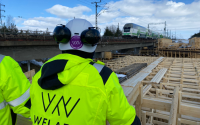In the Vt4 Kirri–Tikkakoski project, a motorway was opened to traffic five months ahead of schedule

In the Vt4 Kirri–Tikkakoski project, a motorway was opened to traffic five months ahead of schedule
The new motorway between Kirri and Tikkakoski on National Road 4 opened to traffic 22 weeks early – and stayed within budget. Welado serves in the project as the customer’s specialist in project management, implementation and all stages of construction.
The 16-kilometre-long new motorway between Kirri and Tikkakoski was inaugurated for use just before Christmas in 2021. At the same time, the transversal roads and new ramps and junctions leading to the motorway were also opened to traffic. Furthermore, the motorway project has involved the construction of 30 bridges, six interchanges, 25 kilometres of pedestrian and bicycle ways and a rock cutting over 30 metres high.
The project will be taken to completion in stages so that the construction of structures on the parallel road and finishing work are completed in 2022. The Kirri interchange area with its ramp arrangements and the third coating layer of the motorway will be completed in 2023, and the final coating layer that withstands heavy use is to be completed in 2026. This achieves an economic and durable solution. Based on the cost estimates of the road plans, the overall project has 141.9 million euros at its disposal.
“This is one of the largest road projects in Finland, and we reached an intermediary goal 22 weeks ahead of schedule and within the assigned budget. Welado’s artisans provide specialist support to the Finnish Transport Infrastructure Agency throughout the Kirri–Tikkakoski project. In the implementation of the project, Welado acts as our representative and monitors that the project proceeds on schedule and according to plans, and also supervises and ensures safety and work quality on the construction sites,” says Jarmo Niskanen from the Finnish Transport Infrastructure Agency (FTIA).
According to FTIA, brisk progress of the work was ensured by such means as utilising new technologies and new methods in design, construction and quality assurance. The project has been realised using the so-called design, build and develop contract model where the contractor's duty to perform contains drafting the final building plan in accordance with prevalent design instructions and regulations.
The design has been realised entirely using models, and hardly any paper blueprints have been created in the project.
Always an easy project – from confusion to clear implementation
As a developer consultant, Welado supervises the realisation of the entire project according to the contract-specific product requirements defined by the customer.
“In practical terms, Welado has really been my eyes, ears and hands, and they're always alert, as a lot of things happen on construction sites. You need to be able to anticipate and react quickly. As the customer, I have been able to fully trust that Welado’s artisans are able to anticipate challenges as the project advances and find the best solutions to them to produce the required result. For me this is an easy project,” says Jarmo Niskanen.
“The openness, honesty and teamwork of Welado people, and their expertise in managing large wholes, fostered an atmosphere of trust where working has been smooth. We solve all problems at one table regardless of roles. Open communication has served us well in reaching our goals,” Jarmo Niskanen continues.
The most difficult challenge of the road project is the beginning
Who does what, where is information stored and how is it managed? These are challenges faced at the beginning of every project. They are solved by creating shared operating models and crystallising the goals shared by everyone. In summary: Everybody understands what we are trying to achieve together.
Welado's Regional Manager Arto Hyvärinen shares his wisdom: “The most difficult challenge of the road project is the beginning. Clarifying the roles, responsibilities and information management practices to all parties involved is the cornerstone of a successful project. There is also a massive number of stakeholder groups – different operators and different needs – that need to be taken into account before implementation begins. Identifying risks and open communication are key in this respect.”
The list of stakeholders in the Vt4 Kirri–Tikkakoski project includes such operators as the ELY Centre of Central Finland, City of Jyväskylä, Municipality of Laukaa, Finavia (airport and operation), Finnish Defence Forces, Regional State Administrative Agency, management and equipment operators, some 400 landowners, private water cooperatives, fire and rescue authorities, maintenance operators, as well as the companies and various other operators in the region.
From chaos to mutual understanding – roles and responsibilities must be clear to all parties
Good management of the whole is based on a clear definition of the responsibilities between customer and contractor. The roles and areas of responsibility must be defined so that everybody understands them the same way. The rules and operating models are agreed on together. This allows everyone to understand what the goal is and who is doing what and when. The job descriptions and tasks must be clear to the customer, the contractor and the designers.
“Welado's operating models and developer artisans emphasise the openness of cooperation and discourse. Work is done by humans and for humans, so trust and openness are foundational pillars. Close and front-weighted communication in the design stage between the different stakeholder groups is crucial to ensure that even the most difficult matters are brought to the table and solved together,” says Arto.
Limiting the project and optimised solutions – stay within the budget
One of the most crucial solutions for the project’s production management and overall success was building the parallel road first. The traffic on National Road 4 could be directed entirely to the parallel road, which allowed the actual motorway to be constructed in a closed construction site environment. This improved safety on the site and prevented traffic from causing any delays to the project. Measures were also taken to minimise disruption to traffic.
“Successful design guidance helps us stay on schedule, budget and agreed-upon quality. Joint design meetings are attended by the main contractor, main designers of the various technical fields and the customer/developer consultant. Together we anticipate and solve all challenges, ensuring that the overall project succeeds in the best way possible,” says Arto.
Data model-based design and construction lead to improved construction quality and efficiency
As construction proceeds, new challenges keep coming up: there are disturbances to traffic and residents in the area, for example. Anticipating these challenges and open communication are crucial to ensure that there are no unnecessary delays or down time on the construction site.
“We at Welado strive to solve possible problems in a front-weighted manner. One way of doing this is to visualise possible events and risks and come up with different scenarios and procedures according to agreed upon operating models. Decisions are made easier by model-based construction, which allows us to gain relatively comprehensive information from the construction site in almost real time,” Arto says.
Data-based real-time quality assurance
Utilising modernised design practices and various technologies during construction make it easier to ensure quality and complete the project efficiently.
Welado uses data and data models produced by the contractor for quality assurance purposes. All parties to the project have access to the systems, and supervisors can see where machines are, what they are doing, which realisation models are active, etc. Quality assurance teams of the contractor and customer handle a tremendous amount of data from sources such as documents, coordinate data, point clouds, photos and drone360 images. The customer has also conducted point checks on bridge and specialty structures for the purposes of point cloud-based analysis where the built structures can be compared to the designed IFC models.
“With the help of model-based design we have been able to proceed with construction and monitor its development and realisation according to plans, even up to the accuracy of millimetres,” Arto concludes.
Did we pique your interest? Read more about our infrastructure development services and how a developer consultant from Welado builds collaboration between different parties.
Contact us! Arto is happy to provide more information.


